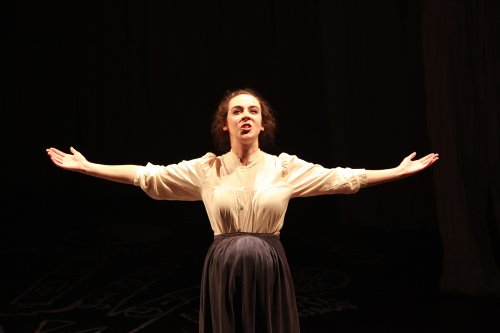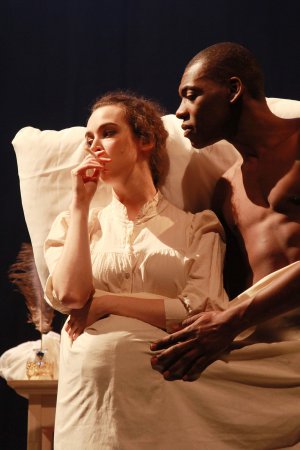Phantasmagoria; or, Let Us Seek Death!
Ambitious biography about Mary Shelley and the genesis of her groundbreaking novel, Frankenstein, but a hodge-podge of too many competing story ideas.

Jane Bradley as Mary Shelley in a scene from “Phantasmagoria; or, Let Us Seek Death!” (Photo credit: Theo Cote)
[avatar user=”Cynthia Allen” size=”96″ align=”left” ] Cynthia Allen, Critic[/avatar]The 2016 La MaMa Puppet Series ends its fall program with Phantasmagoria; or, Let Us Seek Death! However, being called a puppet play is a misnomer; the puppetry (by Benjamin Stuber) is not integral to the play; and what puppetry there is appears makeshift and not up to the standards of such an accomplished designer as Stuber.
Phantasmagoria; or, Let Us Seek Death! is inordinately busy – to its detriment. Playwright Chana Porter tries to tell too many stories; Mary Shelley’s life with the Romantics; the genesis of Shelley’s iconic Frankenstein novel; free love and its consequences; to name but a few. Porter’s intentions are both ambitious and admirable, but the result is a confusing back and forth time travel exercise, where neither Shelley’s biography nor Shelley’s innovative literary experiments are well-served.
Randolph Curtis Rand, who conceived and directs Phantasmagoria; or, Let Us Seek Death!, draws from a coterie of apparitions — one of which is the title of the play. Both Rand and Porter’s “phantom storytelling” takes the first part of its name from a renowned 1802 “magic lantern” exhibition, where the French word phantasmagorie meant a “crowd of phantoms” or ghostly image projections. However, besides the title’s allusion, there is hodge-podge of at least five other ideas in the play which are a jumble and appear and disappear like ghosts, and not fleshed out stories. Even the secondary clause in the play’s title, “or, Let Us Seek Death!,” seems tacked on and vague. Despite the attempt to use college literature lectures integrated into the play as a framing device to link the plot lines together, following what’s what and which story we are in, is challenging.

Jane Bradley and Demetrius Stewart as Mary and Percy Shelley in a scene from “Phantasmagoria; or, Let Us Seek Death!” (Photo credit: Theo Cote)
Jane Bradley energetically portrays an innocent teenage Mary Shelley, and later on, a weary-worn wife. Demetrius Stewart’s rendition of his dual roles as Percy Shelley and Dr. Frankenstein don’t carry the necessary weight needed for such monumental characters. Even with the interesting choice of including ethnic and gender diversity in the role selections, the other actors make perfunctory acting choices, not ingenious ones.
Jessica Greenberg’s expert lighting and sound design adds wonderfully eerie textures throughout. In particular, she renders a fitting sense of macabre when the Frankenstein story comes into play. Kima Baffour’s costumes are period relevant and compatible with the production.

Ashley Winkfield, Katie Melby, Equiano, Andrew Lynch, Benjamin Stuber and Demetrius Stewart in a scene from “Phantasmagoria; or, Let Us Seek Death!” (Photo credit: Theo Cote)
Benjamin Stuber’s puppetry designs are a disappointment and should be more thoughtful and complementary to the play. Ghoulish puppets that are meant to disturb seem make-shift and thrown together. There is only one disturbing and appropriately quirky puppet effect – the appearance of a huge eye, set into a collage background of assorted textiles.
There are interesting tidbits concerning Mary Shelley’s life with the Romantics and her husband, Percy Shelley, but the muddy storylines detract from these reveals. Phantasmagoria; or, Let Us Seek Death! intends to be a memoir that is also erotic and macabre, but is neither.
Phantasmagoria; or, Let Us Seek Death! (through November 6, 2016)
2016 LaMaMa Puppet Series
An Eric Borlang Production
La MaMa Experimental Theatre’s Ellen Stewart Theater, 66 E. 4th Street, between Second and Third Avenues, in Manhattan
For tickets, call 646-430-5374 or visit http://www.LaMaMa.org
Running time: one hour and 55 minutes including one intermission






Leave a comment